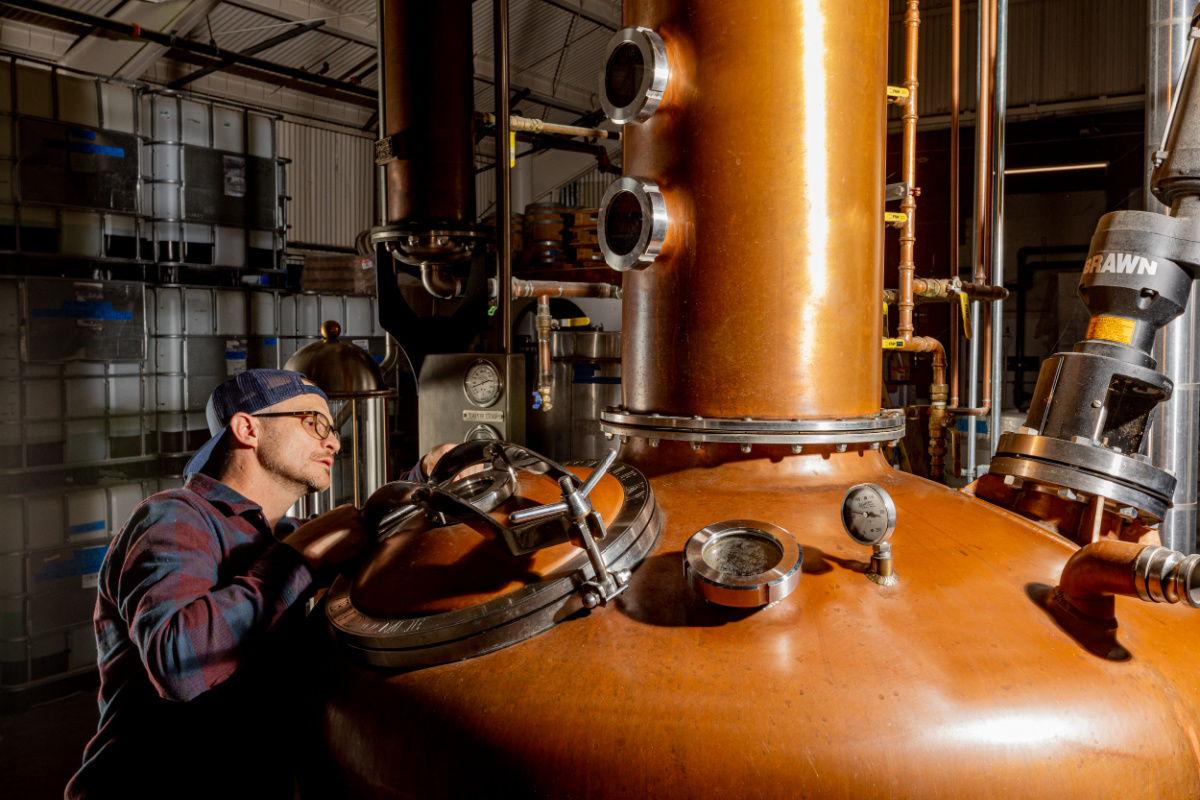Welcome to Cocktail Week, East Bay Nosh’s appreciation of the local mixed drinks scene. Stay with us all week, as we bring you the best in cocktails, mocktails and spirits from businesses in Berkeley, Oakland and beyond.
The East Bay is not the first region that comes to mind when we talk about whiskey, as barrel aged spirits from Kentucky, Indiana and Tennessee have dominated the discussion. Over its years in business, Oakland’s Wright & Brown Distilling Co. (W&B) has been working its way into the conversation with small-batch whiskey, rum, bourbon and rye made in the area’s first known distillery since before the Prohibition.
Since it was founded by Daniel Wright and Earl Brown in 2014, W&B has won several awards for its slowly made craft spirits. According to Brown, they’ve made it this far because they’ve chosen to take the hard road, not the easy one.
“As a small producer, we never wanted to source anything,” Brown told me during a visit to their distillery last week. Many craft distilleries just purchase bulk whiskey from larger producers, Brown said, which is likely a surprise to most folks — then those companies add their label to the product, and that’s what you end up buying.
But that’s a strategy Wright and Brown weren’t interested in, even though it would have made establishing W&B immeasurably easier. Both grew up in rural Humboldt County, where making something from scratch is the default, not the exception.
Wright & Brown Distilling Co.
2715 Magnolia St. (near 28th Street), Oakland
Bottle shop open 1-5 p.m. Tuesday, 1-6 p.m. Wednesday-Saturday
“Doing the production from grain to glass is such a completely different business, experience and knowledge base than the other side, which is taking up products other people made and blending them and marketing them,” Brown said.
“I guess that rural Northern California background, growing up in a farming and ranching country, gave us this kind of belief in doing it that way rather than taking any shortcuts,” Brown said.
During the earliest days of W&B, they created only small batches of spirits, and used 10-gallon barrels as a shortcut in the process. (Traditionally, a 53-gallon barrel is used to seal in flavors from the wood and age the whiskey, but the size of the barrels means aging takes far longer.) While the 10-gallon plan worked — in the short term — to make a reliable product, there was no way that was cost effective or sustainable long term.
“The advantage is you could get a really nice product in a year and a half,” Brown said. “But the disadvantage is that it’s costly and in the long run, your whiskey is definitely better out of a full-size barrel with a proper number of years, in my opinion.” It took two years for W&B to grow into a consistent, year-round production.
Like many distilleries, they were forced to reevaluate their business in 2020, when the pandemic began. Like many of its fellow spirits producers, it pivoted to making sanitizer, using its 250 gallon copper pot still and the leftovers from its brandy production process.
Brown calls it a moment “where the wheels fell off of the systems around the country,” but W&B tried to get some of the wheels back on by donating the sanitizers to local hospitals, emergency responders, and a nonprofit that housed senior citizens. “In a time of crisis it does feel good to step up and contribute something for your community,” said Brown.
The remaining bottles were sold at the distillery. “We had amazing support from the neighborhood, when all the bars and restaurants were shut down,” Brown said.
Now that sanitizer is widely available again, that same giant copper pot still processes W&B’s spirits in a slow, manual process that they say is the secret to their successful bourbon whiskey. This thoughtful distillation approach can be challenging, but there has been a notable payoff: W&B has won several awards for its efforts to make an authentic California whiskey, including nods from the American Distilling Institute, the Good Food Awards and the San Francisco World Spirits Competition.
“There is no California bourbon or California whiskey designation officially,” said Brown. “But it would be kind of a cool thing to have where people look at a bottle and know that was made here. Because right now, you can buy sourced barrels from Kentucky, bring them out here, bottle them, and then you say this is California whiskey.”
That lack of official designation also has an upside: Unlike Tennessee or Kentucky whiskey, California distilleries have a chance to play a little bit more. There also aren’t the boundaries of tradition that other regions are expected to adhere to.
According to Brown, what really makes a whiskey a California whiskey is the use of local resources. W&B purchases its non-GMO grains and other products from farms and businesses throughout Northern California, including Brown’s family farm in Humboldt County. Their heirloom rye comes from farmer friends in Merced, and their corn and barley is grown in Sacramento. This not only supports the local farmers but the California economy, Brown said.
And the more spirits they sell, the more local farmers they can support, giving a socially conscious edge to the next cocktail you make with W&B whiskey, rum or bourbon. And according to Brown, even purchases from a bottle shop keep the dream of California whiskey alive. “People can order from us directly if they’re not near a bottle shop that carries our stuff,” he said, but “if they are, then go support that business and buy our products from it.”
That said, it’s still worth checking out W&B’s bottle shop for some special treats. “We also sell our more unique stuff with the cask strength rye,” Brown said, “and the single malt, [even] when it’s in short supply, will still have it here.”
Featured image: Wright & Brown Distilling Co. co-founder Earl Brown and the company’s 250-gallon copper pot still. Credit: Melati Citrawireja

